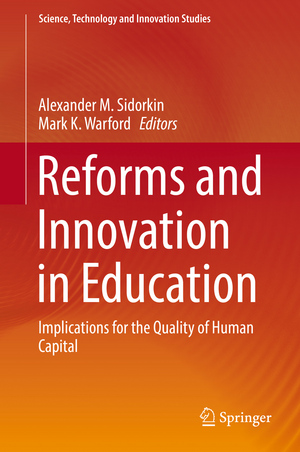Reforms and Innovation in Education: Implications for the Quality of Human Capital: Science, Technology and Innovation Studies
Editat de Alexander M. Sidorkin, Mark K. Warforden Limba Engleză Hardback – 13 oct 2017
Taking labor economics as a useful lens for conceptualizing the diffusion of innovation, in the first part of the book the authors analyze book how certain power arrangements can block educational innovations in schools. In the second part they examine recent educational reforms in the US and Russia. The final part presents a vision of the next generation of educational reforms, which may enable innovation diffusion, rather than hamper it.
| Toate formatele și edițiile | Preț | Express |
|---|---|---|
| Paperback (1) | 883.27 lei 6-8 săpt. | |
| Springer International Publishing – 17 mai 2018 | 883.27 lei 6-8 săpt. | |
| Hardback (1) | 889.12 lei 6-8 săpt. | |
| Springer International Publishing – 13 oct 2017 | 889.12 lei 6-8 săpt. |
Din seria Science, Technology and Innovation Studies
- 15%
 Preț: 362.78 lei
Preț: 362.78 lei - 15%
 Preț: 650.69 lei
Preț: 650.69 lei - 15%
 Preț: 533.20 lei
Preț: 533.20 lei - 18%
 Preț: 950.96 lei
Preț: 950.96 lei - 18%
 Preț: 774.04 lei
Preț: 774.04 lei - 18%
 Preț: 1115.77 lei
Preț: 1115.77 lei - 18%
 Preț: 898.43 lei
Preț: 898.43 lei -
 Preț: 480.83 lei
Preț: 480.83 lei - 18%
 Preț: 886.43 lei
Preț: 886.43 lei - 18%
 Preț: 891.96 lei
Preț: 891.96 lei - 18%
 Preț: 996.46 lei
Preț: 996.46 lei - 18%
 Preț: 1000.56 lei
Preț: 1000.56 lei -
 Preț: 390.08 lei
Preț: 390.08 lei - 18%
 Preț: 1000.87 lei
Preț: 1000.87 lei - 24%
 Preț: 911.57 lei
Preț: 911.57 lei - 18%
 Preț: 1119.56 lei
Preț: 1119.56 lei
Preț: 889.12 lei
Preț vechi: 1084.29 lei
-18% Nou
Puncte Express: 1334
Preț estimativ în valută:
170.14€ • 178.91$ • 140.58£
170.14€ • 178.91$ • 140.58£
Carte tipărită la comandă
Livrare economică 16-30 aprilie
Preluare comenzi: 021 569.72.76
Specificații
ISBN-13: 9783319602455
ISBN-10: 3319602454
Pagini: 237
Ilustrații: V, 142 p. 5 illus., 3 illus. in color.
Dimensiuni: 155 x 235 mm
Greutate: 0.39 kg
Ediția:1st ed. 2017
Editura: Springer International Publishing
Colecția Springer
Seria Science, Technology and Innovation Studies
Locul publicării:Cham, Switzerland
ISBN-10: 3319602454
Pagini: 237
Ilustrații: V, 142 p. 5 illus., 3 illus. in color.
Dimensiuni: 155 x 235 mm
Greutate: 0.39 kg
Ediția:1st ed. 2017
Editura: Springer International Publishing
Colecția Springer
Seria Science, Technology and Innovation Studies
Locul publicării:Cham, Switzerland
Cuprins
Introduction.- 1 Educational Innovation Diffusion: Confronting Complexities.- 2 The Nature of Educational Innovation.- 3 People Matters: Innovations in Institutionally Weak Context.- 4 Innovators from Within and from Without the Education System.- 5 Identifying Factors Associated with the Survival and Success of Grassroots Educational Innovations.- 6 Understanding Technology Integration Failures in Education: The Need for Zero-Order Barriers.- 7 Human Capital and Innovations in Education.- Conclusion.
Notă biografică
Alexander M. Sidorkin currently serves as Dean of the College of Education at Sacramento State University, and has a research appointment at National Research University Higher School of Economics. His scholarly interests include philosophy and economics of education, educator preparation, and innovation studies in education.
Mark Warford of State University of New York College at Buffalo is Chair of Modern and Classical Languages and a Research and Innovation Felllow for the SUNY Center for Online Teaching Excellence. His main areas of scholarship include: educational innovations, sociocultural theory, applied linguistics, and teacher development.
Textul de pe ultima copertă
This book investigates the interrelationship between educational reforms and pedagogical and technological innovations, as well as the implications of this relationship for the quality of human capital. By analyzing recent educational reforms in Russia and the US, the authors shed new light on how these reforms may help or hinder innovations, such as the introduction of computer technologies into classrooms, new methods of teacher evaluation, constructivist teaching methods, and governance in public schools.
Taking labor economics as a useful lens for conceptualizing the diffusion of innovation, in the first part of the book the authors analyze book how certain power arrangements can block educational innovations in schools. In the second part they examine recent educational reforms in the US and Russia. The final part presents a vision of the next generation of educational reforms, which may enable innovation diffusion, rather than hamper it.
Caracteristici
Analyses recent educational reforms in the US and Russia Investigates the interrelationship between educational reforms and pedagogical and technological innovations Shows how to make educational organizations and systems more innovation-friendly
